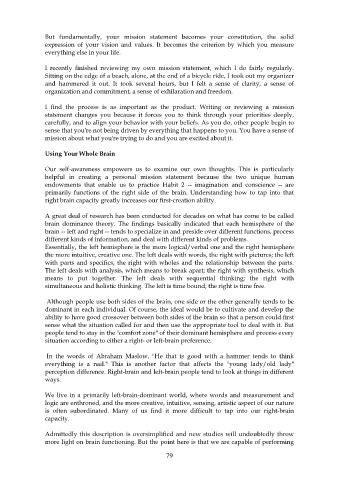Page 80 - Stephen R. Covey - The 7 Habits of Highly Eff People.pdf
P. 80
But fundamentally, your mission statement becomes your constitution, the solid
expression of your vision and values. It becomes the criterion by which you measure
everything else in your life.
I recently finished reviewing my own mission statement, which I do fairly regularly.
Sitting on the edge of a beach, alone, at the end of a bicycle ride, I took out my organizer
and hammered it out. It took several hours, but I felt a sense of clarity, a sense of
organization and commitment, a sense of exhilaration and freedom.
I find the process is as important as the product. Writing or reviewing a mission
statement changes you because it forces you to think through your priorities deeply,
carefully, and to align your behavior with your beliefs. As you do, other people begin to
sense that you're not being driven by everything that happens to you. You have a sense of
mission about what you're trying to do and you are excited about it.
Using Your Whole Brain
Our self-awareness empowers us to examine our own thoughts. This is particularly
helpful in creating a personal mission statement because the two unique human
endowments that enable us to practice Habit 2 -- imagination and conscience -- are
primarily functions of the right side of the brain. Understanding how to tap into that
right brain capacity greatly increases our first-creation ability.
A great deal of research has been conducted for decades on what has come to be called
brain dominance theory. The findings basically indicated that each hemisphere of the
brain -- left and right -- tends to specialize in and preside over different functions, process
different kinds of information, and deal with different kinds of problems.
Essentially, the left hemisphere is the more logical/verbal one and the right hemisphere
the more intuitive, creative one. The left deals with words, the right with pictures; the left
with parts and specifics, the right with wholes and the relationship between the parts.
The left deals with analysis, which means to break apart; the right with synthesis, which
means to put together. The left deals with sequential thinking; the right with
simultaneous and holistic thinking. The left is time bound; the right is time free.
Although people use both sides of the brain, one side or the other generally tends to be
dominant in each individual. Of course, the ideal would be to cultivate and develop the
ability to have good crossover between both sides of the brain so that a person could first
sense what the situation called for and then use the appropriate tool to deal with it. But
people tend to stay in the "comfort zone" of their dominant hemisphere and process every
situation according to either a right- or left-brain preference.
In the words of Abraham Maslow, "He that is good with a hammer tends to think
everything is a nail." This is another factor that affects the "young lady/old lady"
perception difference. Right-brain and left-brain people tend to look at things in different
ways.
We live in a primarily left-brain-dominant world, where words and measurement and
logic are enthroned, and the more creative, intuitive, sensing, artistic aspect of our nature
is often subordinated. Many of us find it more difficult to tap into our right-brain
capacity.
Admittedly this description is oversimplified and new studies will undoubtedly throw
more light on brain functioning. But the point here is that we are capable of performing
79

